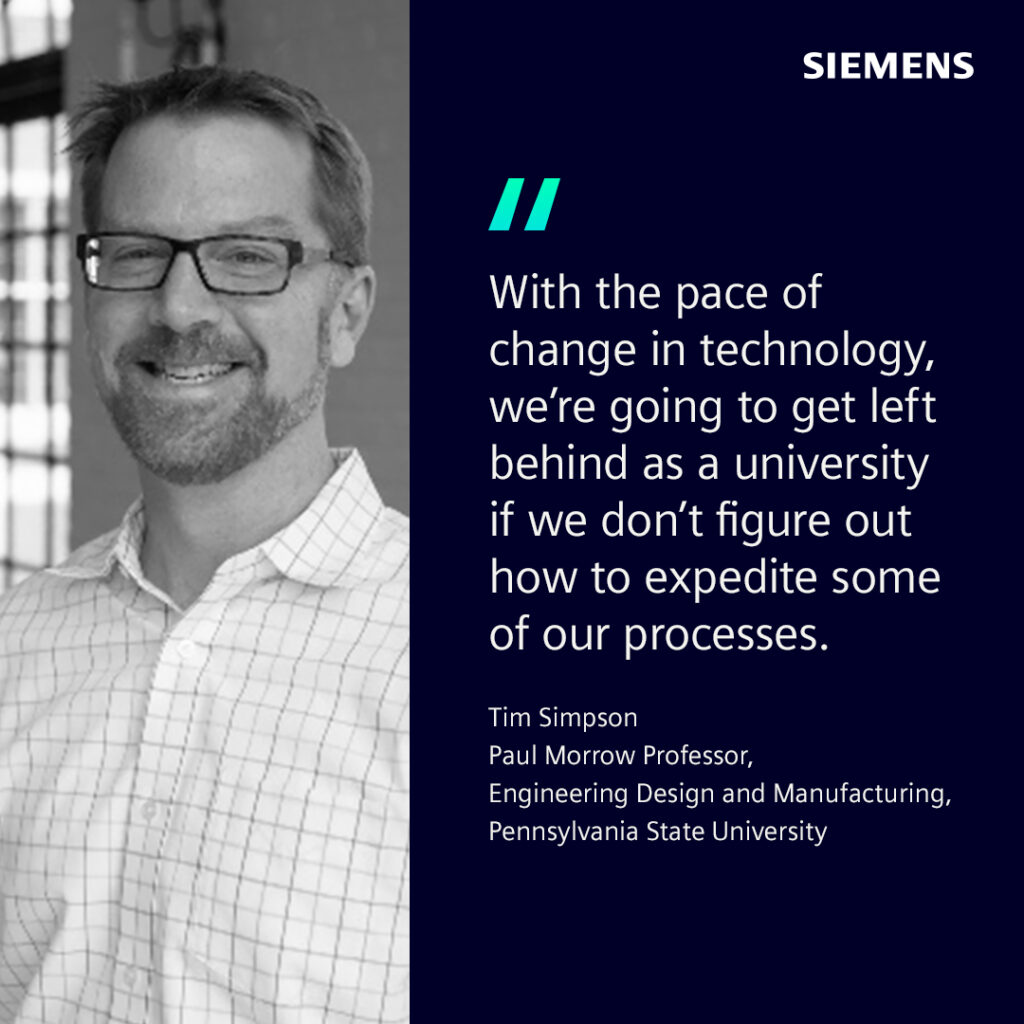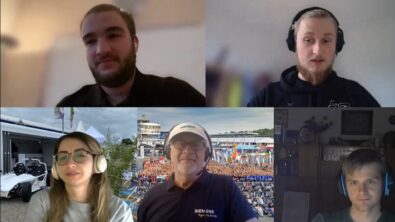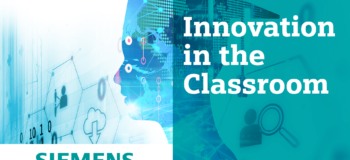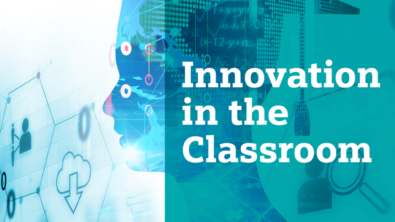播客原文:不断变化的技术对学术界的影响

我们经常谈论弥合产业界和学术界之间的差距,但我们如何确保两者之间的成功合作?学术界如何跟上工业技术的快速发展?学术界如何培养出业界如此迫切需要的对技术充满热情的学生?
在这一期的“课堂创新”中,我们的主持人Dora Smith和宾夕法尼亚州立大学Paul Morrow工程设计和制造教授Tim Simpson一起探讨了这些问题。蒂姆和他的学生已经在多达600个项目上与数百家不同的公司合作过。他们最近的工作包括寻找保护航空生态系统的方法。
在这节课中,朵拉和蒂姆讨论:
- 技术的发展如何改变了学术界
- 蒂姆在学术界是如何与业界保持联系的
- 学术界如何跟上行业的快节奏
- 蒂姆与业界合作的经验
- 蒂姆目前在NASA工作
- 蒂姆在大流行最严重时期在学术界工作的经历

请收看完整集,了解更多蒂姆关于学术界如何与工业界合作的想法!
与蒂姆联系
播客成绩单
朵拉:欢迎来到西门子赋能教育团队的“课堂创新”。开云体育平台登录我是朵拉·史密斯。
我们经常谈到弥合产业界和学术界之间的差距。对于大学来说,这意味着能够与行业伙伴建立互利的关系,以便让学生获得有意义的行业经验。
今天的嘉宾蒂姆·辛普森对这类合作并不陌生。蒂姆是宾夕法尼亚州立大学工程设计与制造专业的保罗·莫罗教授,他和他的学生们已经与数百家公司进行了多达600个项目的多元化合作。最近的工作包括寻找保护航空生态系统的方法,以及在大流行最严重时期3d打印面罩和其他个人防护装备。
在这节课中,蒂姆将带领我了解他与行业打交道的经验,并分享他如何在融合行业和学术界时偶尔遇到的挑战中与公司建立有价值的关系。他还扩展了他和他的学生参与的一些合作,以及他从这些经历中得到的收获。
蒂姆:在课堂上的创新方面,我班上的学生和以前的学生都有3D打印机,当他们听到这个消息时,他们都说,我能帮上什么忙?所以我们建立了一个整体,不仅仅是来自公司的供应链,我们还有一个学生方面的整体,他们有3D打印机,其他研究生,就像,把3D打印机搬出实验室,就在他们关闭一切之前。所以他们借了。也许不应该这么说。但无论如何,现在我们有一个请求,哦,我需要,你知道,我需要100个这个或50个这个或其他什么。我们可以让学生马上说,是的,我可以帮忙检查,并创建一个完整的分销网络来获得东西。好时需要这个,好吧,哪个学生离好时最近?现在他在家了?好吧,打印出来送过去。这里是落点之类的东西。
朵拉:多学科合作、不断发展的技术和不断变化的行业标准可以使教授在其职业生涯中获得多个不同层次的经验。蒂姆告诉了我一些他在宾夕法尼亚州立大学的经历,以及是什么让他取得了今天的成就。
蒂姆:我在宾夕法尼亚州立大学已经待了将近25年,主修机械工程和工业工程,所以我的背景更多地是在产品设计开发方面。但过去10年左右,现在,深入研究3D打印和添加剂并没有意识到兔子洞会有多深,与学生分享如何使用3D打印进行产品设计和开发。但现在,这是一项变革性的技术,我认为它正在颠覆和改变很多东西的制造和设计方式。我一直在试图理解这些含义是什么?那么与公司合作会有什么影响呢?然后,我们如何将这些知识带回到课堂,让学生为就业做好准备?
朵拉:正如我刚才提到的,不断发展的技术也见证了学术界的同步变化。我问蒂姆,他在宾夕法尼亚州立大学的职业生涯中是否经历过类似的事情。
蒂姆:在大学环境中生活了25年是非常有趣的,当然,通过iphone和ipad之类的数字创新浪潮,到我们现在的位置。我认为它在某种意义上变得至关重要。我们大学是知识宇宙的中心,对吧?改变到了学生们通过YouTube在线学习的程度,他们在幼儿园里做翻转课堂。所以当他们进入大学时,他们的期望与过去大不相同。所以我认为这确实是一种转变你作为教员的角色是什么?从知识传播的角度,到学习的角度,你在做什么?如果要我说的话。
朵拉:如果我们要讨论数字创新以及它在学术界所扮演的角色,我们当然需要讨论工业。毕竟,由于这是许多学生的最终目标,学术界必须尽可能准确地反映行业。蒂姆告诉我,作为一名教授,他是如何与业界保持密切联系的。
蒂姆:所以我在产品设计和开发方面的研究,我一直在尝试有什么方法和工具可以帮助设计师和工程师做出更好的决策。所以我一直认为,为了验证和验证这一点,我需要与工程师和公司交谈。所以最初,我是通过研讨会和其他东西进入一家公司,分享这个或那个,然后得到反馈。有一次,我有机会管理我们的高级顶点设计项目。所以现在我尝试着通过学生项目将公司带回课堂。,你知道,在过去的六、七年,我跑了,你说的数百种不同的公司想出五到六百个不同的项目,我们必须范围和识别,对,所以我开玩笑,你知道的,用这个作为一个机会在我的游戏行业工作,这样我就更熟悉什么行业关心他们寻找什么,他们为什么要与大学合作项目等,现在我在这个加法领域,我更能更容易地阐明我们所做的工作对公司的好处是什么,现在他们感兴趣的是什么。他们是A:想多谈谈B:想和我们一起做一个项目吗?所以现在我们已经能够创造一种良性循环,我们在项目上与公司合作,因为我们很幸运,这里有一些最先进的设备。但每一次参与都会带来三个新的研究项目,然后你就会出去,你知道,与公司分享,然后获得,你知道,获得下一轮的兴趣。 So throughout my career, trying to A: put myself out there to B: engage and interact with companies both to test my ideas, but also make sure that what I’m doing is relevant to them at the end of the day.
朵拉:与工业界合作似乎确实是让学生为“现实世界”做好充分准备的答案。但它并非没有挑战。例如,当学术界习惯于以慢得多的速度前进时,它如何与行业的快节奏相匹配?
蒂姆:我认为这是你在大学环境下与公司合作时遇到的大问题,对吧?他们不以学期为单位,试着调整一些相对的东西,我什么时候有学生?或者项目什么时候可用?他们在季度和财政年度,预算计划发生得比你想象的要早得多。因此,人们会想,哦,公司没有数百万美元用于研发,他们只是在等着寻找好的想法。你要认识人,你要了解他们的方向,你要进入,你知道,进入预算周期,你要把握时机。我认为教师,我认为我们被NSF和一些政府机构宠坏了,这些机构在资助基础研究等方面很好,但我们有很大的灵活性。什么时候开始?结果是什么?你知道,我的里程碑和可交付成果是什么? And oh, I can delay that a bit to start it in the fall when my student is here. Versus companies, I’ve got money now that I need to spend, and I need an answer in three to six months or whatever, versus a year. So it is a different mindset, it is a different game, there are different rules that you got to figure out whether you want to play them or not.
朵拉:那么,有了里程碑、可交付成果和有限的灵活性,蒂姆和他的学生是如何成功地与行业合作的呢?
蒂姆:我认为我们很幸运。再说一次,现在是2020年,对吧?我真希望我能早点计划好。但在我们的Sim 3D实验室,那是我们的加法实验室,我们有教师和学生,但我们也有全职的技术人员和研究人员。所以现在我发现,如果我需要更早开始一个项目,或者做一些短期的事情,我可以去找一个研究人员,让他或她在一个项目上帮助我,而不需要做通常的周期,或者如果这是一个短期的事情。另一件事是我引入了一个教室,我现在和更多的本科生一起工作。因为我发现,如果我发现一个一年级或二年级的学生对CAD或3D打印感兴趣,如果他们是美国公民,如果有必要,我会从自己的钱包里付钱给他们,因为他们是如此罕见,我们做的很多工作都是与国防部和国防有关的,对吧?所以我需要美国公民。但我发现,如果我让他们参与工资发放,在这里花几个小时,在那里花几个小时,他们就是在跟踪一个研究生。如果我们在课程中与这些学生合作,或者两三年,当他们大四的时候,他们可以管理和运行一个项目,他们知道如何运行一个软件程序。开云体育官网入口 And so now I can have an undergrad that’s basically running a research project at a fraction of the cost on his or her time, over the summer, whatever. That’s good for the students, it’s good for the company, it saves money. It’s just it’s win, win, win win. But it takes a while to get that ramp up because you’re not just going to let a freshman who’s come in or a sophomore off and running, but we’ve got a good Honors Program, right. So I can start finding students early on getting them accustomed to what is research who are the equipment this than the other so that by the time junior senior year, they’re running a project and most of the times those companies want to hire those students right away. So it becomes a direct pipeline for talent for each of those companies.
朵拉:在宾夕法尼亚州立大学的职业生涯中,蒂姆和他的学生们与数百家不同的公司合作过500到600个不同的项目。像这样的数字肯定会产生多样性,我问蒂姆为什么跨行业合作很重要,以及到目前为止他的经验是什么。开云体育官方下载
蒂姆:我运行的顶点项目,叫做我们的学习工厂。当我接手时,它主要是在机械工程和制造方面的项目。去一家汽车公司,一家航空航天公司,设计这个小部件,测试它,诸如此类的事情。当时有一种强烈的兴趣,我们如何扩展其他院系,希望为他们的学生提供类似的实践经验,但计算机科学的学生不一定需要学习如何使用铣床或车床,以及如何切割金属。你知道,我们必须弄清楚,对于计算机科学专业的学生,对于生物医学专业的学生,对于这个和那个,对于航空航天专业的学生来说,什么是类似的实践,对吧?那么这如何融入他们的课程呢?行业在哪里以及如何利用这一点,为他们提供有意义的、现实的、吸引人的教育体验?这是第一步。第二步,公司意识到公司不是按行业划分的,而是按规模和成熟度划分的,这是另一回事。所以一个大型的航空航天或汽车公司在一天结束的时候,他们会考虑做一个项目,他们会从团队中雇佣最好的两三个学生。 So it’s a very different sort of focus, that project is much more a recruiting tool. But uh, you know, you make it an engaging recruiting tool in the end versus if you’re working now with, say, a startup or an early stage company, they’re much more interested in, you know, what, what is the latest 3D printing technology to then help me with this? Or how do I think about that, or I need a, I need a proof of concept or a prototype in 15 weeks. And so the outcome and hardware is different for those projects and customers. But at the same time, these are students, this is an educational experience, this is not a contract, you know, those sorts of things. So you gotta be careful managing expectations of all of those companies, you know, these students are not your workforce for a semester, right? And so you got to protect the students at the same time, and you got to manage expectations for company, but hopefully you can find and usually this is where I spend a lot of my time as director, is really what is that middle ground, that sweet spot where you’re both gonna get something useful out of this without overextending or over exerting either party?
朵拉:我们刚刚听说了行业如何满足学生需求,但是学生如何满足行业需求呢?我问蒂姆,在学生招聘方面,公司在寻找什么,以及不同类型的公司对学生的需求有什么不同。例如,一家初创公司是否与一家老牌公司寻求同样的东西?这些都是如何与整体学生体验联系在一起的呢?
蒂姆:企业家的心态当然有点不同。如果一个学生想走那条路,开自己的公司,或者成为小公司的一部分,我认为,你知道,当你在小公司工作时,你有更多的角色和责任,你不会有数百名电气工程师来做电气工程工作。只有你和另外三个人,总得有人来完成。所以当你走这条路而不是另一条路时,你必须更适应,更敏感,思维更开放。我认为这是有趣的事情之一,因为我们在不同的部门之间工作得更好。所以回到我之前的评论,当一个航空航天或汽车公司来找,嘿,我想雇佣机械工程师,这是一个机械工程项目,相反,你知道,一个创业公司或企业家会来说,哦,好吧,我想做这个小部件来展示这个和演示那个。现在我需要学生学习机械,工业,电气,等等。所以你现在有一个非常跨学科的多学科团队。因此,这些学生,从这个项目的性质来看,将会更多地接触到跨学科的工作,学习如何跨越界限,讲不同的语言,而不是我只是为一家汽车公司设计这个支架并进行测试。所以很多学生会去寻找,所以我们现在的项目,在250个项目中,75%的项目至少包含两个学科。 And you know, over half of them had three or more disciplines, as we, as we figured out what was that hands on experience for those other disciplines to come together? And so students could now work for a small, and we saw that students would be like, oh, well, yeah, I thought I wanted to go work for big company, but oh, here’s this little startup that I can get involved, and I meet the owner and the three other people, and now they feel they can make an impact much more quickly in a smaller company, and some students really liked that. And others didn’t. Right. So it became sort of a way of dipping your toes in the water. I’d say most internships were traditional large companies. Here’s a way to sort of dip my toes into this startup world, this entrepreneurial world, this small company world and see, do I like that? Or do I enjoy sort of having a place to hide right, among others? And so some indirect benefits of those types of experiences.
朵拉:当涉及到这些项目时,为学生提供多样性的好处是,它可以为他们的职业生涯指明正确的方向。他们有机会亲身体验在不同公司工作的经历,如果幸运的话,还能找到自己的激情所在。
蒂姆:我想你们肯定能看出来。学生们想为X公司设计喷气发动机,对吧?所以我要做的一切,我的课程,我的实习生,所有的一切都是为了这个。我会选一个项目来做。我想其他一些学生,是在另一端。我的专业是机械,就像我们现在告诉和提醒学生的那样,学位不是你的职业,对吧?所以即使你获得了机械工程的学位,你的职业生涯也可以在任何地方。所以利用这些课堂经验,项目经验去探索不仅仅是寻找你可能喜欢的,当然也要排除你不喜欢的。所以现在就变成了,嘿,这就是我对大一大二学生的建议,你现在不需要知道你要去哪里。但是选择你认为你会感兴趣的东西。 And then when you’re done with that internship or that project make sure to reflect on it and understand it, did you like it or not? Because knowing where you don’t want to go is just as helpful as knowing where you would like to go.
朵拉:我离开了他在宾夕法尼亚州立大学的工作,问了蒂姆关于他在太空世界中正在进行的另一个项目。
蒂姆:今年我有一个很酷的新机会,和NASA一起工作,是他们转换成复杂系统设计组的一部分。所以我们有一个IPA,我从宾夕法尼亚州立大学借来一半的时间和NASA一起工作,试图帮助探索这个围绕航空生态系统健康和健康的项目。如果你想想,在商业航空公司、民用航空公司、国防公司之间,但现在是电动、飞机、无人机送货和包裹——天空很快就会变得拥挤起来。所以NASA的这个团队正试图研究这个问题,了解这个问题的挑战是什么?它有多邪恶?如果有的话,NASA和其他机构应该在这方面扮演什么角色呢?想想看,比如联邦航空局,负责政策和监管,这些方面,他们也做研究。波音公司和其他公司都有商业利益,所有这些初创公司都在发展。但是谁能看到整个供应链,对吧?我们有足够的材料来制造无人机和电动飞机所需的电池吗? Who’s coordinating the chargers for this, that and the other, not to mention the better, we need more aerodynamic, we need lighter weight, new regulations around drones flying overhead. If drones are flying down the highway to deliver packages, right? What safety requirements if they fall out of the sky, and heaven forbid, hit somebody or bounce on a car or bounce on the sidewalk. So it’s early, but things are changing a lot. And I don’t know whether we’ll get to the Jetsons in the future, but certainly the skies are gonna get a lot more crowded, and it’d be good to know that somebody’s thinking about making sure everybody is safe, and things are operating effectively.
朵拉:正如蒂姆提到的,飞机和无人机的出现,甚至未来可能出现的飞行汽车等因素,使维持航空生态系统的健康和健康成为重中之重。他接着解释了他是如何参与这项工作的。
蒂姆:有一个组织叫做聚合航空解决方案,简称CAS。所以他们试图在NASA内部进行创新。所以你可以想象一个大型政府机构和那些方面。我需要注意我说什么和不说什么,但是我们怎样才能更有创新性呢?想想100多年前NASA成立的时候,它是为了帮助羽翼未丰的航空业,对吧?莱特兄弟刚刚发现了如何飞行,我们现在还没有公司。所以当时的NASA,在帮助这个行业的发展和成功方面发挥了重要作用,我认为,现在,我们在100年之后,100年之后,对吧。现在我们有各种各样的新东西可以飞起来,在先进的空中机动的标题下,那么航空的未来是什么样子的?我们的供应链准备好了吗?不仅可以把客户和人员送到他们需要的地方,还可以运送包裹和零件等诸如此类的东西。团队已经开始考虑这个问题,认识到这是一个重要的领域。 A good friend of mine that I was talking with was at NASA, I was telling her about sort of the supply chain issues during the pandemic that we faced. I ended up leading a team of almost four hundred People at Penn State, trying to make sure that the supply chain and materials are ready for PPE and for keeping our healthcare workers safe. And it was like, Oh, hey, how would you like to think about that for the US in terms of aviation? And I said, okay, yeah, let’s try see what it is.
朵拉:随着人类在天空中的活动越来越多,蒂姆与NASA所做的工作非常重要,这已经不是什么秘密了。为了充分理解其中的原因,我请他把它放在背景中。
蒂姆:还有其他一些项目已经在进行,比如,如果无人机现在在建筑物之间或周围飞行,对吧?我们如何解释上升气流和风以及所有这些东西,因为没有好的规则或指导方针。我们知道建筑物在太空中离人行道有多近,这样风就不会吹翻你的雨伞。但如果我想让无人机载着一个20磅重的包裹降落在屋顶上。是的,祝你好运,对吧?谁,谁研究这个?你如何模拟它?你如何建模呢?更别说在安全的环境下测试了。这里还有其他各种元素。这个项目的时间安排,与我刚入职时相比的供应链,以及我的背景,这两者联系得很好,但我肯定也和很多其他项目的负责人谈过。 You can simulate it right. But then how do we get the data to validate that? Now we need sensors on buildings to capture the wind patterns to do that, oh, well, who? Who does that? Is it the architect? Is it the building designer? It turns out, NASA also has one of the biggest, if not the biggest wind tunnel test facility in the country, in Armstrong, which is where it could test a whole space shuttle. So it’s like, let’s build some small scale cities and put it in there. I can’t wait to walk through that one during a future trip.
朵拉:所以,如果我们把它与学术界联系起来,学生们如何能够接触到蒂姆正在做的工作,并从中受益?
蒂姆:从教育的角度来看,我的天哪,这让我看到了这么多不同的事物和视角。你知道,我们刚刚在宾夕法尼亚州立大学推出了一个新的法律政策和工程项目。这一切都是关于法律和政策以及这些系统的工程如何相互作用,以确保美国供应链保持有效。我在跟供应链研究中心的同事聊天,我们怎么付款?你们一直在建模和分析吗?是的,我们可以使用什么工具,我们如何将其扩展到足够大的范围,对吧?我不想白费力气。让我们走出去,把所有这些不同的东西联系起来。所以在工程,商业,法律和政策中,你知道,甚至是,与增材制造的一些方面联系在一起,说,嘿,如果我不能足够快地得到我的零件,何时何地打印替换零件以安全返回我的飞机是有意义的,或者做这个或那个?因此,还有一个全新的领域可以为未来的研究活动提供信息。
朵拉:我很好奇地想知道蒂姆在大流行最严重时期在学术界工作的经历。从之前的谈话中,我知道他与世界各地的学校合作,并带来了在虚拟环境中学习的独特方法。我请他就这个问题多讲一点。
蒂姆:在课堂上创新和国际交往?我当时正在教一门3D打印课程,当时疫情爆发,学生们突然不能回到教室了。那么现在,我们要如何进行动手实验呢?我不知道。我开始在网上寻找,然后在捷克共和国,当然,在意大利,我记得意大利人,他们正在用3D打印技术,替换呼吸机的部件。所以现在突然间,a:你可以这么做,但是B:嗯,这有什么法律含义?a它开始创造这样的对话。在捷克共和国,他们现在在分享,就设计和创新而言,创客社区是相当开放的。所以人们开始分享面罩和口罩的设计。所以我改变了学生项目,考虑到COVID,让我的学生设计和开发一个可以3D打印的想法。所以他们在那里进行活动。 Then I was also talking to some of my colleagues down at our College of Medicine saying, are you seeing this, is this coming? What’s going on down there? And they were like, oh, yeah, you know, this is. We’re keeping a close eye on this. We should start trying some of these things.. We should start prototyping just to be ready. So all of a sudden, we’re taking designs that have been developed in Czechoslovakia, in Italy, in Europe, downloading them now. They’ve been shared freely online. We’re downloading those, we’re printing, we’re making our face shields and doing our own prototyping, we’re then making changes and uploading and sharing those and, and that was right at the start of when this sort of all took off. So as things got more and more intense, all of a sudden, this sort of grassroots network of 3D printers and makers that I had just pulled together over email, the senior leadership was like, hey, I hear you got a team in there. We’re saying we’re gonna run short on this. And I think literally that day, we had just made our first prototype. So I replied to the email saying, oh, yeah, I got a team looking into this and here’s a picture of our face mask, and we’ll have our first respirator tomorrow, right. And they were just like, what? So Laura Weiss, Senior VP of research, and I think we talked on Friday, that night, she was like, do you want to leave this thing? And I’m being naive, I don’t know exactly what’s going to happen, right. This is a pandemic, who knows what’s up. But so I raised some money internally, we had a website, we had a name, we launched on Monday, hey, here’s this group that’s going to help this, we had a co-lead down in College of Medicine in Hershey. We started every day, we had an hour long call with the doctors, the chief surgeon, oh, now the head of supply chain, that head of procurement gets on and he say like, I can’t get any of this stuff. So we started a list. By the end of the week, we had gone from like 30 people to 150 people, our projects went from like five or six red things to like 40, red things by the end of the week, just simple. Red, green, yellow, spreadsheet right? And then we would meet and talk every day, just what, where do we source this? What can we 3D print? How do we connect that? And then we grew it from there. So that was classroom innovation that connected this, we started sharing our ideas broadly with others across the state, we networked across all the campuses, to Penn State’s 24 campuses across the whole state. So when we were getting calls from hospitals in Philadelphia, or Pittsburgh, or other areas, and a lot of other campuses have already started similar efforts. So we connected them, we put in a whole quality system, we had a whole check to make sure everything was compliant. I had Chief of medical, I had legal, we worked with local companies to then finally, make sure things were GMP compliant. So we had to build out our own supply chain model of all the companies in Pennsylvania that we could work with, and source from and do all of this. Necessity is the mother of invention, right? Created our own network identified companies and sort of figured it out as we went. So most exciting, tiring, exhilarating, 100 days, ever, as a professor at a university, I’ll tell you what.
朵拉:对蒂姆来说,在日常工作之外还要做这些事情一定是一种紧张的经历。我问他是否从这次经历中学到了什么东西,改变了他的教学方式,改变了他对教学的看法。
蒂姆:是的,我认为对我来说,我觉得我是一个经营自己公司的企业家,尽管是在大学的安全范围内。这给了我一个不同的视角和经验,然后把它带回到我的课程中,无论是在设计、3D打印还是与供应链人员交谈等等。现在它把我们和医学院联系得更紧密了,他们试图看看我们能不能做3D打印定制植入物和医疗设备。它创造了一个完整的经验网络,见解,现在已经改变了我如何教我教的东西,然后也改变了谁,以及我如何与他人交往。所以在这方面,这是非常值得的,现在这是令人惊讶的,因为最初的100天,每个人都被封锁了,我们甚至不知道。所以我和一些人合作,但我从未见过面,我们每天都会见面,在Zoom上见面一个小时,这个团队或那个团队,这很有趣,当一切恢复时,我出去跑步或在杂货店,我听到一个声音。我就想,哦,天哪,那是某某人,对吧?就好像,你已经习惯了这些声音,你知道,这些声音在现实世界中所表现出来的差异。有人说,哦,天哪,查理,你是我的邻居,那是你在遛狗,我都不知道。我们在一起工作三个月了,对吧? So that was pretty funny. We all went through a shared experience together there, right. And so still when we see each other, and these things, it’s just it bonded us in a way that, we never thought possible, even though we were all remotely on Zoom and Teams and separated, 90 miles apart between State College and in Hershey. So not only the supply chain sort of experience that I had there, because I had to set up a whole logistics and sourcing and procurement and transportation departments, quote, unquote, within that team, find leads and do all this sort of stuff. But the other piece was, it was clear to me now between Zoom and 3D printing and CAD models, we were able to collaborate pretty seamlessly, no matter where we were on those teams, no matter where we were located physically. And so that’s actually one of the other pieces that I’m hoping to look into with NASA, this particular group is spread across four different centers. So Langley, Glenn, Ames and Armstrong on the West Coast, right. And they’ve got makerspaces and engineering design studios, right? How and what can we do? What can we learn from our experiences that might help them collaborate better across different centers? I’m just starting to have some of those discussions, I got to tour there for, I was up at Glenn a couple of weeks ago and toured their maker Engineering Design Studio. So I’m excited to see where that goes over the coming year as well.
朵拉:为了结束我们的谈话,我问蒂姆,关于产业界和学术界之间的合作,他是否有更多深刻的见解。以下是他所说的。
蒂姆:现在的公司需要投资回报率,对吧?所以如果你不能清楚地表达你的工作的价值是什么,它将如何增加收入,节省成本,你知道,把事情做得更快,更好,而不仅仅是因为你有一个好主意,外面有100个好主意,对吧。学会如何让自己与众不同。实际上我认为另一个会议和期刊,有趣的是,我可以与你分享,所以两个月前,我的ASME会议,我赢得了这个大研究奖,,但无论如何,当我在那里,得到这个奖,他们正在读我所有的引用计数,而且,你知道,所有这些赞誉,它之前,我给所有的工作,我与公司行业,我就明白了,这些数字只在那个房间里的人,其他的教师和研究生,他们是唯一关心这些数字的人,他们吹嘘的东西,帮助我赢得了那个奖项。我从来不会和我合作或互动的公司谈论这些事情。我甚至,当我去参加一个研讨会或介绍我自己的时候,我甚至不会谈论有多少出版物或有多少网站或其他什么,因为那对公司来说,你知道,那几乎就像你为什么在那里的桌子上的赌注。显然,你已经发表了文章,人们知道了你的工作,否则,你还在实验室里工作。所以这都是关于你如何通过你的工作传递价值并产生影响?所以我做了一个即兴表演,谢谢观众。 And then I challenged everybody at the end of that I started to realize that sort of faculty were in sort of our academics were sort of in our own box, the journal right. Because everything we do is like, get me to that next journal paper to then, you know, repeat the Circle of Life, write proposals to get money to fund students, to do research to put, you know, to write a journal paper, repeat, repeat, repeat, repeat. So I challenged everybody to think outside the journal in terms of the impact that you want to have. So this ties to that sort of, the only way to disseminate knowledge is through conference insurance. Well, companies don’t read those, there’s too many, and they don’t have time. And most of those are behind a paywall. So you need other channels to get out there. And so, you know, I just sort of off my gut said think outside the journal. And then I had over a dozen people that afternoon come up to me talking about their impact that they couldn’t find a way to publish it, or there was something they were excited about, that they couldn’t talk about in the regular channels. And so, as I was flying back home, I got on Google on like, think outside the journal, think outside the journal, nobody, nobody had done any of that, plenty to think outside the box. So I went on substack. And I started writing a blog monthly blog called Think Outside the Journal that is going to share the sorts of stories and how to have an impact beyond, you know, that next journal paper.
朵拉:也许合作中最重要的部分是沟通。业界应该经常与学术界联系,看看他们需要什么,反之亦然。为了结束我们的谈话,蒂姆雄辩地解释了为什么这是如此重要。
蒂姆:我认为,有了现在的知识,学生们可以通过所有这些平台和其他东西获得和利用这些知识。我认为,能够脱颖而出的教室和教授将能够与这些公司进行有意义的互动,创造真实的现实世界体验,这将丰富学习环境。如果我讲的是F = MA之类的,现在任何人都能在网上找到。因此,我认为我们正处于一个转折点,或者说是一个转折点,我们需要开始以不同的方式思考,公司、教师、行业和大学如何合作,培训和教育未来的劳动力,甚至是当前的劳动力,对吗?你的员工怎么会有3D打印课程,五年,更别说十年前,他们需要学习这些东西,对吗?他们会回来修30个学分然后拿到我们的增材制造学位吗?也许吧,但我们现在比以往任何时候都需要一种不同的参与方式来帮助培训和教育人们。回到你之前的观点,我没有回到你的观点,但我认为现在的结果是技术变化的速度。这种融合正在发生,作为大学,如果我们不知道如何加快我们的进程,我们就会落后。这对我来说更可怕。 Because even if I teach a course on 3D printing, right for a semester, by the end of that, there’s already at least one or two new hardware and software companies that made you know three lectures irrelevant now. So we have to be more agile in what we’re teaching, how we’re teaching, when we’re teaching, than we’ve done previously. And the world is gonna pass us by. It’s not the big eats the small, right? It’s the fast eat the slow. So if you’re not moving fast, you’re gonna get left behind.
朵拉:感谢蒂姆·辛普森教授花时间给我讲述产业界和学术界合作的重要性,以及他和他的学生在宾夕法尼亚州立大学所做的令人印象深刻的工作。有这么多和他们合作的公司,有这么多他们参与的项目,我相信在教室里永远不会有沉闷的时刻。
无论你在哪里做播客,请继续关注创新课堂。开云体育备用网址我是朵拉·史密斯。谢谢收听!



